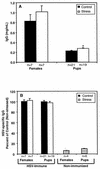Transplacental transfer and subsequent neonate utilization of herpes simplex virus-specific immunity are resilient to acute maternal stress
- PMID: 12767981
- PMCID: PMC156180
- DOI: 10.1128/jvi.77.12.6613-6619.2003
Transplacental transfer and subsequent neonate utilization of herpes simplex virus-specific immunity are resilient to acute maternal stress
Abstract
Neonates are severely compromised in the ability to generate an immune response to pathogens and thus rely heavily on maternally derived immunity that is acquired by transplacental and transmammary means. The passive transfer of maternal herpes simplex virus (HSV)-specific antibody is critical in determining the outcome of neonatal HSV infection. In adults, psychological stress alters immune responsiveness via the increased level of corticosterone that is produced as a result of hypothalamic-pituitary-adrenal axis activation. Although the behavioral and neuroendocrine effects of pre- and postnatal stress-induced increases in corticosterone are well documented, the effects of maternal stress on the efficacy of prenatally transferred and neonatally developed viral immunity has yet to be addressed. By using a well-established prenatal restraint-and-light stress mouse model, we investigated the effects of increased maternal corticosterone on the passive transfer of total and HSV-specific immunoglobulin G (IgG) antibody and subsequent neonatal susceptibility to HSV infection. Serum corticosterone levels in pregnant mice were significantly increased in response to restraint-and-light stress, and fetuses derived from these stressed mice had significantly elevated levels of corticosterone. Despite the increases in corticosterone, the passive transfer of total and HSV-specific IgG antibody persisted and, in turn, protected the neonate from systemic viral spread. Therefore, prenatal stress did not increase the susceptibility of neonates to HSV type 2-associated mortality. These findings demonstrate the resiliency of the passive transfer of protective HSV-specific immunity under conditions of acute psychological stress.
Figures



Similar articles
-
Impact of maternal stress on the transmammary transfer and protective capacity of herpes simplex virus-specific immunity.Am J Physiol Regul Integr Comp Physiol. 2004 Dec;287(6):R1316-24. doi: 10.1152/ajpregu.00685.2003. Epub 2004 Aug 12. Am J Physiol Regul Integr Comp Physiol. 2004. PMID: 15308492
-
Prenatal transfer of low amounts of herpes simplex virus (HSV)-specific antibody protects newborn mice against HSV infection during acute maternal stress.Brain Behav Immun. 2004 Jan;18(1):15-23. doi: 10.1016/s0889-1591(03)00115-6. Brain Behav Immun. 2004. PMID: 14651943
-
Postpartum maternal corticosterone decreases maternal and neonatal antibody levels and increases the susceptibility of newborn mice to herpes simplex virus-associated mortality.J Neuroimmunol. 2004 May;150(1-2):48-58. doi: 10.1016/j.jneuroim.2004.01.012. J Neuroimmunol. 2004. PMID: 15081248
-
Innate immunity to herpes simplex virus type 2.Viral Immunol. 2003;16(4):475-90. doi: 10.1089/088282403771926300. Viral Immunol. 2003. PMID: 14733735 Review.
-
Role of antibody-dependent cellular cytotoxicity in neonatal infection with herpes simplex virus.Rev Infect Dis. 1991 Nov-Dec;13 Suppl 11:S950-2. doi: 10.1093/clind/13.supplement_11.s950. Rev Infect Dis. 1991. PMID: 1664132 Review.
Cited by
-
Corticosterone impairs dendritic cell maturation and function.Immunology. 2007 Oct;122(2):279-90. doi: 10.1111/j.1365-2567.2007.02637.x. Immunology. 2007. PMID: 17848165 Free PMC article.
-
Maternal stress induces epigenetic signatures of psychiatric and neurological diseases in the offspring.PLoS One. 2013;8(2):e56967. doi: 10.1371/journal.pone.0056967. Epub 2013 Feb 22. PLoS One. 2013. PMID: 23451123 Free PMC article.
-
Trivalent Glycoprotein Subunit Vaccine Prevents Neonatal Herpes Simplex Virus Mortality and Morbidity.J Virol. 2020 May 18;94(11):e02163-19. doi: 10.1128/JVI.02163-19. Print 2020 May 18. J Virol. 2020. PMID: 32188735 Free PMC article.
-
Nutritionally mediated programming of the developing immune system.Adv Nutr. 2011 Sep;2(5):377-95. doi: 10.3945/an.111.000570. Epub 2011 Sep 6. Adv Nutr. 2011. PMID: 22332080 Free PMC article. Review.
-
Maternal immunization confers protection against neonatal herpes simplex mortality and behavioral morbidity.Sci Transl Med. 2019 Apr 10;11(487):eaau6039. doi: 10.1126/scitranslmed.aau6039. Sci Transl Med. 2019. PMID: 30971454 Free PMC article.
References
-
- Arvin, A. M. 1991. Relationships between maternal immunity to herpes simplex virus and the risk of neonatal herpesvirus infection. Rev. Infect. Dis. 13(Suppl. 11):S953-S956. - PubMed
-
- Barlow, S. M., P. J. Morrison, and F. M. Sullivan. 1975. Effects of acute and chronic stress on plasma corticosterone levels in the pregnant and non-pregnant mouse. J. Endocrinol. 66:93-99. - PubMed
-
- Bonneau, R. H., D. A. Padgett, and J. F. Sheridan. 2001. Psychoneuroimmune interactions in infectious disease: studies in animals, p. 483-497. In R. Ader, D. Felten, and N. Cohen (ed.), Psychoneuroimmunology, 3rd ed. Academic Press, San Diego, Calif.
-
- Coe, C. L., and H. R. Crispen. 2000. Social stress in pregnant squirrel monkeys (Saimiri boliviensis peruviensis) differentially affects placental transfer of maternal antibody to male and female infants. Health Psychol. 19:554-559. - PubMed
-
- Coe, C. L., J. W. Kemnitz, and M. L. Schneider. 1993. Vulnerability of placental antibody transfer and fetal complement synthesis to disturbance of the pregnant monkey. J. Med. Primatol. 22:294-300. - PubMed
Publication types
MeSH terms
Substances
Grants and funding
LinkOut - more resources
Full Text Sources
Other Literature Sources
Medical

